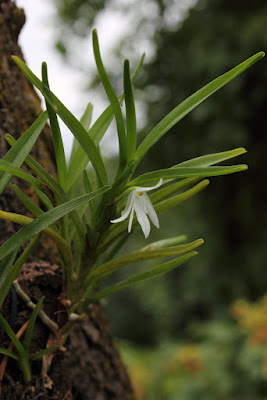Jumellea anjouanensis is endemic to Comoros Islands and it occurs only on two of the four islands, Grande Comore and Anjouan. This species grows in lowland and montane forests at elevations of 450 to 1900 meters.
Jumellea anjouanensis also called as The Anjouan Jumellea, Angraecum anjouanense, is a species of the genus Jumellea. This species was described by Joseph Marie Henry Alfred Perrier de la Bâthie in 1941.
IDENTIFY JUMELLEA ANJOUANENSIS ORCHID PLANT
Jumellea anjouanensis is endemic to Comoros Islands and it occurs only on two of the four islands, Grande Comore and Anjouan. This species grows in lowland and montane forests at elevations of 450 to 1900 meters. It has also been found in dense secondary forest characterized by Psidium and Syzygium, or in dense Philippia thickets.
It is a small to medium sized, hot to cool growing epiphyte with erect to pendant, rigid, compressed stems carrying towards the apex, 5 to 7, folded, keeled, bilobed apically leaves.
The Anjouan Jumellea blooms in the spring summer and fall on an axillary, very short, single flowered inflorescence.
JUMELLEA ANJOUANENSIS ORCHID PLANT CARE AND CULTURE
Cultural information should only be used as a guide, and should be to be adapted to suit you. Your physical location; where you grow your plants, how much time you have to devote to their care, and many other factors, will need to be taken into account. Only then can you decide on the cultural methods that best suit you and your plants.
Light:
Jumellea anjouanensis needs a light level of 15000-30000 lux. Light should be filtered or diffused, and plants should not be exposed to direct midday sun. Strong air movement should be provided at all times.
Temperature:
Summer days temperature at average 29°C, and nights temperature at average 23°C, with a diurnal range of 6-7°C.
Humidity:
The Anjouan Jumellea need the humidity of 80-85% most of the year, dropping to near 75% for a month or so in late winter.
Substrate, growing media and repotting:
Jumellea anjouanensis may be grown in shallow, well-drained containers or mounted on tree-fern slabs. Mounted plants need high humidity, however, and during hot, dry weather they may need several waterings a day.
If it is difficult to keep mounted plants moist enough, they may be grown in a shallow pot or basket filled with a very open, fast-draining medium that has excellent drainage, is well aerated, and allows the medium to dry fairly rapidly after watering.
Growers generally use medium-sized fir bark or shredded tree-fern fiber and add varying amounts of chunky perlite and/or chopped sphagnum moss to keep the medium open and retain some moisture. Including charcoal in the mix also holds the medium open and prevents souring in the pot.
Plants should be repotted immediately if the medium starts to break down or whenever the plant outgrows its container. Repotting should be done just as new roots start to grow. This enables the plant to become reestablished in the shortest possible time.
Watering:
Rainfall occurs from late spring into autumn. Averages decrease rather rapidly into a dry season that lasts 4-5 months in winter and early spring. Cultivated plants should be watered often while actively growing, but drainage should be excellent and conditions around the roots should never be allowed to become stale or soggy. Water should be reduced in late autumn when plants are no longer actively growing.
Fertilizer:
1/4–1/2 recommended strength, applied weekly when plants are actively growing. You can use a balanced fertilizer throughout the year; but also can use a high-nitrogen fertilizer from spring to midsummer, then switch to one high in phosphates in late summer and autumn.
Rest period:
Winter days temperature at average 25-26°C, and nights average 19-21°C, with a diurnal range of 5-6°C. Water should be reduced for Jumellea anjouanensis plants in winter, allowing them to become somewhat dry between waterings. They should never be allowed to dry out completely, however. Fertilizer should be reduced or eliminated until new growth starts and heavier watering is resumed in spring.















COMMENTS